THE STATE OF EXCITEMENT!
Why Travel To Tassie To Go Saltwater Fishing?
Everyone knows Tasmania offers the best trout fishing in the country. But why should you consider travelling there to fish in the salt, and potentially catch exactly the same species that are available locally? Steve Starling has some answers to that question…
Since the Spirit of Tasmania vehicle ferry moved its mainland home from Port Melbourne to Geelong a year or so ago, numbers of South Australians travelling to the Apple Isle have definitely increased. The drive to get there and back may only be slightly shorter, but there’s much to be said for avoiding Melbourne’s inner-city gridlock!
I suspect the vast majority of keen South Australian anglers who pack a rod or two and head to Tassie — either by plane or boat — have trout very much on their minds. Fair enough, too. The Devil’s Playground is justifiably renowned for its world-class trouting: be it skinny-water sight fishing in the shallow tarns of the Western Tiers, chasing trophies in the big hydro lakes, or dropping a dry fly on the speckled head of a busily rising fish in a gorgeous lowland stream. But what if I were to tell you that Tasmania’s saltwater fishing is also in a league of its own, and well worth travelling there to experience? Trust me, it’s true! So true, in fact, that it now draws myself and my wife Jo south with our trailer boat in tow on an almost annual basis. (We’d go even more often if we could but, unfortunately, it’s a fairly expensive exercise.)
SO, WHAT’S ON OFFER?
A short list of some of the more spectacular offshore marine fisheries on offer in Tasmanian seas would definitely have to include its southern bluefin tuna, albacore, mako sharks, broadbill swordfish and striped trumpeter. There’s also a reasonable sprinkling of yellowfin tuna and striped marlin caught off the island’s east coast each year, although you wouldn’t hang your hat on scoring either of those species down there, and would be better off heading to NSW if they are the most important items on your personal bucket list.
But it’s not all about deep, blue water and big game or reef fish. The inshore, bay and estuary fishing around Tasmania is also first class and, for whatever reason, it seems to be getting better and better every year! Sure, most of us know it’s home to a heap of big bream, but there’s also much more to it than that.
Three species, in particular, epitomise the evolving nature of Tassie’s inshore saltwater fishing in an age of warming seas, stronger currents, and the widespread adoption of modern tackle and techniques. That trio of targets are snapper, yellowtail kingfish and King George whiting. Over the past 15 years all three have gone from being virtually unknown in most Tasmanian waters — or at least, the sole province of dedicated, switchedon specialist anglers — to widely available and commonly encountered.
WORLD’S BEST WHITING?
While South Australia definitely has more and bigger yellowtail kings and snapper (when an where you’re allowed to fish for the latter species!) than Tasmania, there’s a very valid argument these days that our only island state is actually home to the biggest and best King George whiting on the planet.
I can already imagine thousands of sets of South Australian eyebrows shooting skyward at that contentious claim, and many chests swelling with state-proud indignation, but after a couple of trips to Tassie specifically chasing whiting, I stand by my controversial call. South Australia might have a lot more whiting than Tasmania, but if you’re specifically chasing ‘trophy’ fish over 50 cm in length, with a good chance of encountering a 60-plus, Tasmania is actually THE place to be these days!
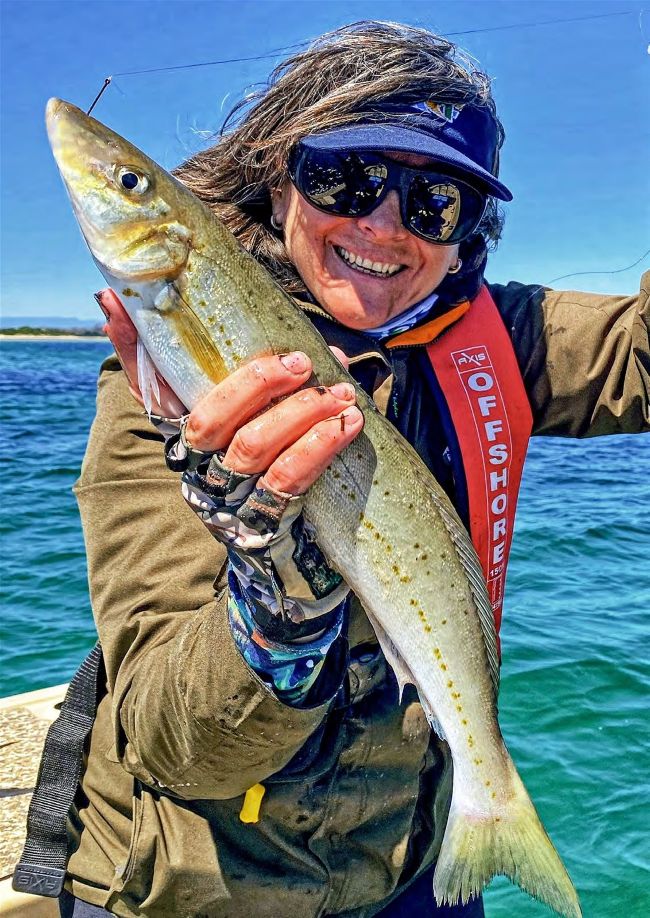
Jo Starling with another “average” Tasmanian King George!
More specifically, I’m talking about Tasmania’s northern, Bass Strait coastline and upper east coast. From Woolnorth and Montagu on the island’s far northwestern corner, to St Helens on its north east coast, seriously large whiting are now being caught on a very regular basis through a big chunk of the year (October until May seems best, although they can mysteriously vanish from many inshore areas in April).
Interestingly, these fish also seem to be ranging further south each season, too. They’re now reasonably common down to at least the Freycinet Peninsula in the east, and a few surprising stragglers have even turned up way down the bottom end, in Dover and Southport! But if you’re serious about chasing a “sixty”, it’s that northern coastline you should be thinking about.
Hot spots are many, but include the already named Woolnorth and Montagu in the far north west, as well as Devonport, Port Sorell, the lower Tamar, Low Head, Bridport, Waterhouse, Tomahawk, and around the corner to Musselroe, Ansons and Georges Bay, at St Helens — plus dozens of other places in between that I haven’t mentioned. A quick scan of the map or Google Earth will help to identify many more.
At all of these locations big King George whiting are available both close to shore in shallow, semienclosed waters (some are even caught by land-based anglers), as well as out onto more traditional inshore grounds over broken reef, weed and sand patches in two to eight or nine metres of water.
GETTING THERE AND DOING IT
Of course, it can’t all be good news, and it isn’t. The three biggest limiting factors on Tasmania’s amazing, world-class whiting fishery are the state’s fickle (and often foul!) weather, a scarcity of decent boat launching facilities in many whiting-rich locations, and the fact that there isn’t an established charter boat industry with a tradition of targeting these fish. However, when you stop and think about it, those three limitations may also be a major part of the reason why there are so many big whiting down there!
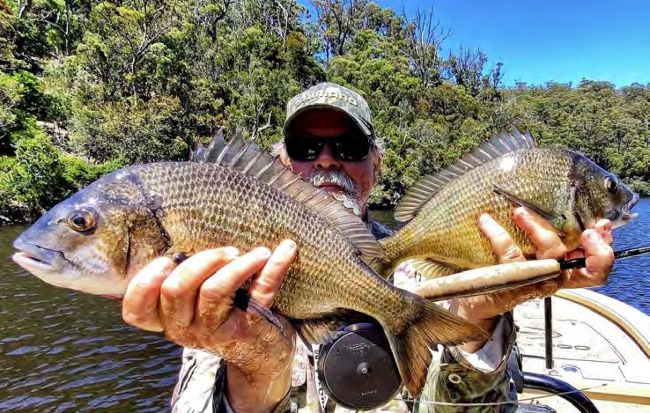
Yes, there are big mobs of bream in Tasmania… but that’s not all!
Tapping into this fishery yourself, as a visitor from the mainland, can be tricky. The way we’ve chosen to do it is to load up our vehicle, hitch up the boat and catch the ferry across. But, as I mentioned earlier, this is far from being a cheap option! You really need to be going over for at least three weeks or a month to justify the arm and leg charged by the Spirit of Tasmania for getting you there and back. Going for that long should also ensure you luck into at least a couple of decent weather “windows”.
For shorter or fly-in trips, you’ll need to rely on a friendly local, hire a boat, or make use of one of the very few professional guiding services that have so far keyed into this fishery and have it well wired. The best of those, to my knowledge, is Peter Donati of Unique Fishing Tours Tasmania, who is based in Launceston and mostly fishes the lower Tamar and adjacent waters. You’ll find Peter’s website at www.uniquefishingtours.com.au or you can call him on 0400 619 169. Make sure you tell him Starlo sent you! (by the way, Peter’s a gun trout guide, too.)
For boat (and tow vehicle) hire, I simply can’t fault Clinton Howe of Tassie Boat Hire in Ulverstone, whose rigs are absolutely perfect for the task. You’ll find Clinton’s site at www.tassieboathire.com.au and you can call him on 0429 475 550. Once again, make sure you tell him Starlo sent you and he’ll look after you.
WHAT OF THE FUTURE?
Very wisely, in my opinion, Tasmania’s fisheries managers have recognised the massive value and importance of the state’s relatively “new” whiting fishery, and have done their best to safeguarded its future via the imposition of the country’s tightest and most conservative regulations for the species.
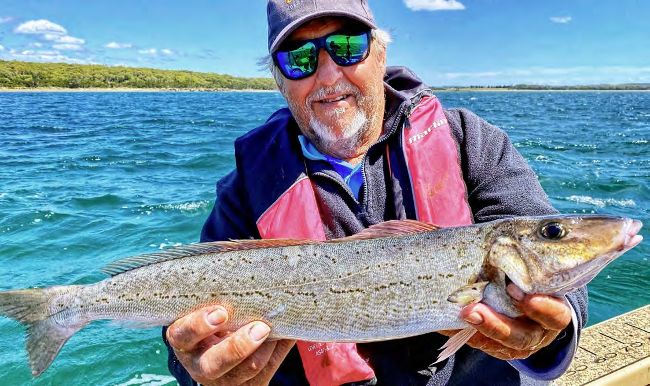
Believe it or not, a 55cm 1.2kg whiting like this is nothing particularly out of the ordinary in northern Tasmania these days!
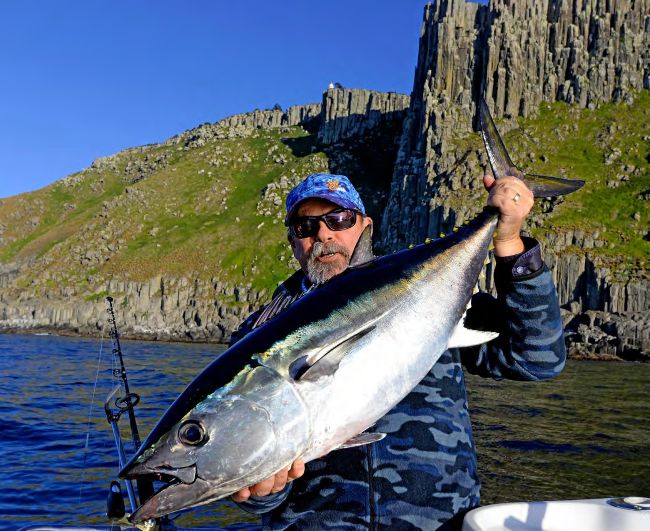
A bluefin from spectacular country in the island state’s south east
At the time of writing, the minimum legal length for King George whiting in Tasmania was 35 cm and the daily, per-person bag limit was five fish... Yes, five over 35! That’s not a misprint, and it will probably shock some people reading this. However, I believe it’s a really smart piece of regulation, and will help ensure that this astounding fishery continues to go from strength to strength.
To be honest with you, when Jo and I take our boat south on the Spirit to chase whiting, we very rarely keep more than five between us for a day, and generally set a voluntary minimum length of 45 cm — carefully releasing anything smaller. Trust me, five ’ting over 45 cm in length feeds us a couple of times over, and we’d rather head back out and catch a couple more when we run out of fresh fillets at camp. Yes, it’s a very different attitude to the “bag out at all costs” mentality that seems to drive so many mainland whiting fishers, but I believe its an approach that sits beautifully with what is fast emerging as the world’s premier, blue-ribbon King George fishery. I hope you agree.
Until next time, Tight Lines!
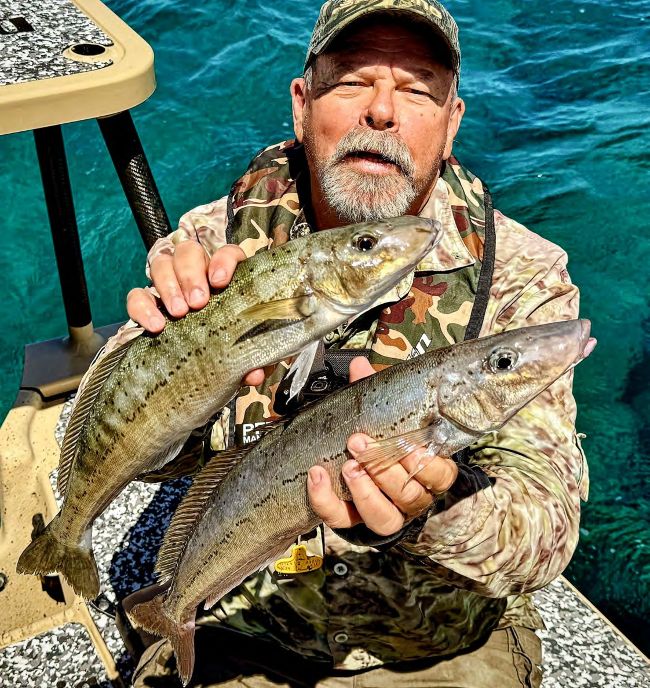
Starlo upped his King George whiting ‘PB’ to 55cm on his latest visit to Tassie… he’s still chasing that elusive 60!